Eastern Seaboard Hospitals Overwhelmed With Flu-Stricken Patients
- Share via
PHILADELPHIA — How bad is the flu bug right now on the East Coast? Take a look at the emergency room at Temple University Hospital.
Flu-stricken patients waiting for rooms are lined up on gurneys in the halls. Others wait, then wait some more before being seen by a doctor.
“The flu shot apparently is not doing its job, and from all reports, it could be one of the worst seasons we’ve seen in years,” said Dr. Robert McNamara, chief of emergency medicine at the hospital.
The flu, which struck the West hard last month, has arrived like a storm in the East, filling hospital waiting rooms and doctors’ offices with sniffling, feverish, achy patients.
“We’re having difficulty getting inpatient beds. We have been in a critical status for the last 11 days,” McNamara said. “It’s so crowded that if you’re healthy and you walk into the hospital, you’re at risk of getting the flu.”
Heather Brown, 24, of Wrentham, Mass., was sick much of Tuesday and Wednesday. Her symptoms were so severe, she believes it may have been something even more serious than the flu.
“People told me I had the flu. I said ‘No, no, no.’ I was violently throwing up from both ends. This can’t be just the flu,’ ” Brown said. “I slept for 20 out of 24 hours.”
At South Georgia Medical Center in Valdosta, Ga., supervisors went from wearing business suits to white nurses’ coats to help with the crush of mostly flu-ridden patients.
Some hospitals have been forced to reschedule elective operations or divert ambulances to other hospitals. Lehigh Valley Hospital in Allentown, Pa., is so swamped that, for the first time, it has asked flu patients to call ahead.
The situation is so bad at Claremont Nursing and Rehabilitation Center near Carlisle, Pa., that visitors are banned through at least Sunday.
The first substantial numbers of flu cases were reported in California and Arizona last month. Since then, 19 states--including Pennsylvania, New York, New Jersey and Virginia--have reported widespread or regional flu activity, according to the Centers for Disease Control and Prevention.
“We’ve been used to seeing it in late January, February and even March,” said Dr. Luther Rhodes, chief of infectious disease at Lehigh Valley Hospital. “We weren’t thinking about it over the Christmas holiday.”
Flu symptoms include fever, coughing, stuffy nose, headache, muscle aches and extreme fatigue. The flu can develop into pneumonia. Those considered at risk of serious complications include infants, the elderly and people with chronic illnesses such as AIDS, diabetes or heart disease.
More to Read
Sign up for Essential California
The most important California stories and recommendations in your inbox every morning.
You may occasionally receive promotional content from the Los Angeles Times.













